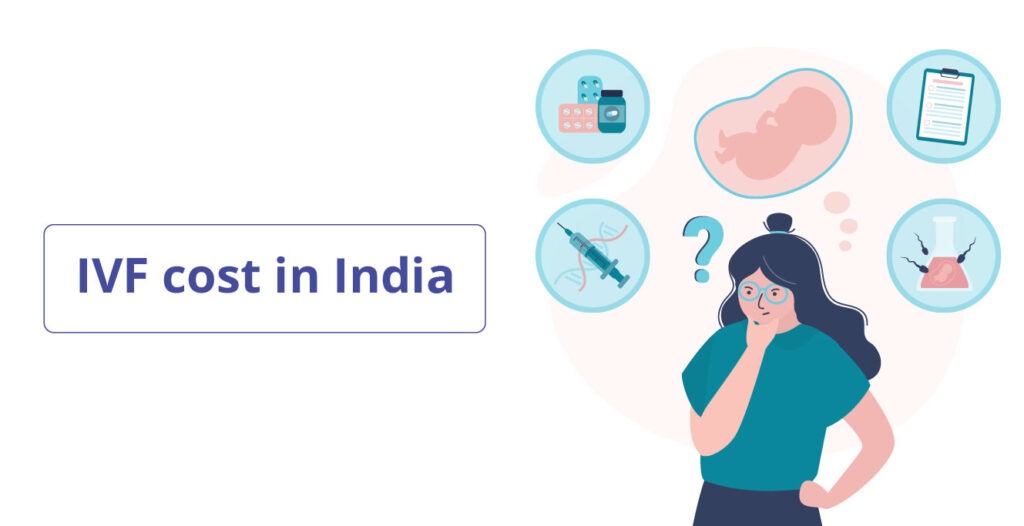For many individuals and couples facing fertility challenges, In Vitro Fertilization (IVF) offers the promise of parenthood. However, one of the most significant considerations when embarking on an IVF journey is the financial aspect. IVF costs can vary significantly, and it’s essential to navigate this aspect with clarity and planning. In this comprehensive guide, we will explore the factors that contribute to IVF costs, potential insurance coverage options, and strategies to manage the financial aspects of IVF treatment.
Understanding IVF Costs
IVF costs can be influenced by several factors, making it important to have a clear understanding of what contributes to the overall expenses:
- Diagnostic Testing: Before beginning IVF, you may undergo various diagnostic tests to assess your fertility status. These tests can include bloodwork, ultrasounds, and genetic screening, which come with their associated costs.
- Medications: Fertility medications are a significant part of IVF, helping stimulate the ovaries for egg production. Medication costs can vary depending on the individual’s response to treatment and the type of medications prescribed.
- Egg Retrieval and Embryo Culture: The surgical procedure to retrieve eggs and the subsequent culturing of embryos in a laboratory setting are essential steps in IVF, and they come with associated costs.
- Sperm Processing: In cases of male infertility or when using donor sperm, sperm processing and testing may be necessary, adding to the overall expenses.
- IVF Procedure: The actual IVF procedure, including the fertilization of eggs and embryo transfer, incurs costs, which can vary depending on the clinic and any additional techniques used, such as Intracytoplasmic Sperm Injection (ICSI).
- Additional Services: Some IVF clinics offer additional services like preimplantation genetic testing (PGT) and embryo freezing. These services come with their own fees.
- Multiple Cycles: Success with IVF is not guaranteed in a single cycle. Some individuals or couples may require multiple cycles to achieve a successful pregnancy, each of which incurs additional costs.
Potential Insurance Coverage
While IVF is often considered an elective procedure, some insurance plans may offer partial or full coverage for fertility treatments. Here are some key points to consider regarding insurance coverage:
- Employer-Based Coverage: Some employers offer fertility benefits as part of their employee healthcare plans. It’s crucial to review your benefits package and understand what fertility services are covered.
- State Mandates: Several U.S. states have passed laws mandating insurance coverage for fertility treatments, including IVF. These mandates vary from state to state, so it’s essential to check the regulations in your state.
- Lifetime Maximum: Even if your insurance plan offers coverage for IVF, there may be a lifetime maximum limit on benefits. Be sure to inquire about these limits.
- Preauthorization: Some insurance plans require preauthorization for fertility treatments. It’s important to follow the necessary steps to ensure your treatment is covered.
- Out-of-Pocket Costs: Even with insurance coverage, there may still be out-of-pocket costs, such as deductibles, copayments, and coinsurance. Understand these costs before proceeding with IVF.
Strategies to Manage IVF Costs
Navigating the financial aspect of IVF can be challenging, but several strategies can help manage the expenses:
- Insurance Advocacy: Work closely with your healthcare provider’s billing department to navigate the insurance process. They can help you understand your benefits, obtain preauthorization, and maximize coverage.
- Flexible Spending Accounts (FSAs) and Health Savings Accounts (HSAs): If available, consider using FSAs or HSAs to pay for IVF-related expenses with pre-tax dollars.
- Budgeting: Create a detailed budget that outlines all anticipated IVF costs, including medications, procedures, and additional services. Having a clear financial plan can help you stay on track.
- Financing Options: Some IVF centers offer financing options or payment plans to help spread out the cost of treatment over time. Explore these options with your clinic.
- Grants and Scholarships: There are organizations and foundations that offer grants and scholarships to individuals and couples facing financial barriers to fertility treatment. Research and apply for these opportunities.
- Consider Clinical Trials: In some cases, participating in a clinical trial related to fertility treatments may offer reduced or waived costs.
- Alternative Financing: Explore alternative financing options like personal loans or credit cards, but be mindful of interest rates and repayment terms.
- Consultation with a Financial Advisor: Consider consulting with a financial advisor who specializes in healthcare expenses. They can help you develop a personalized financial plan for IVF.
Conclusion
Navigating the financial aspect of IVF can be a complex and emotionally charged process. It’s crucial to approach it with a clear understanding of the costs involved, potential insurance coverage, and strategies to manage expenses effectively. While IVF may be a significant financial commitment, many individuals and couples find that the journey to parenthood is well worth the investment.
Remember that every fertility journey is unique, and there is no one-size-fits-all approach to managing IVF costs. Seek guidance from your healthcare provider, insurance company, and financial professionals to create a plan that aligns with your specific circumstances and goals. With careful planning and the right support, you can take meaningful steps toward achieving your dream of parenthood.
Title: “Exploring the Advantages and Factors to Keep in Mind Regarding Preimplantation Genetic Testing (PGT) in In Vitro Fertilization (IVF)”
In the realm of assisted reproductive technologies, Preimplantation Genetic Testing (PGT) is a remarkable advancement that has revolutionized the field of In Vitro Fertilization (IVF). PGT allows for the genetic screening of embryos before they are implanted in the uterus, offering a range of benefits and considerations for individuals and couples undergoing fertility treatment. In this comprehensive guide, we will explore the fundamentals of PGT in IVF, its various applications, the potential advantages, and the important considerations for those considering this technology as part of their fertility journey.
Understanding Preimplantation Genetic Testing (PGT)
Preimplantation Genetic Testing (PGT), formerly known as Preimplantation Genetic Diagnosis (PGD), is a laboratory technique used in conjunction with IVF. It involves the examination of embryos for specific genetic or chromosomal abnormalities before they are selected for transfer to the uterus. PGT encompasses three primary types:
- PGT-A (Aneuploidy Screening): This type of PGT screens embryos for aneuploidy, which refers to an abnormal number of chromosomes. Aneuploidy can lead to conditions like Down syndrome and can result in failed implantation or miscarriage.
- PGT-M (Monogenic/Single Gene Disorders): PGT-M is used when one or both parents carry a known genetic mutation that can cause a specific genetic disorder, such as cystic fibrosis or sickle cell anemia. It allows for the selection of embryos free from the identified genetic mutation.
- PGT-SR (Structural Rearrangements): PGT-SR is employed when one or both parents have structural rearrangements of their chromosomes. This type of testing can identify embryos with balanced translocations or inversions, which may result in pregnancy loss or developmental issues.
Benefits of Preimplantation Genetic Testing (PGT)
PGT in IVF offers several significant benefits, which contribute to its growing popularity among individuals and couples pursuing fertility treatment:
- Increased Pregnancy Success Rates: By selecting embryos free from genetic abnormalities or mutations, PGT can enhance the chances of successful implantation and a healthy pregnancy.
- Reduced Risk of Genetic Disorders: PGT-M can significantly reduce the risk of passing on known genetic disorders to the offspring, providing peace of mind to families with a genetic history of such conditions.
- Minimized Risk of Miscarriage: Aneuploidy screening (PGT-A) helps identify embryos with chromosomal abnormalities, reducing the risk of miscarriage due to genetic issues.
- Selective Transfer: PGT enables the transfer of the most viable and genetically healthy embryos, optimizing the chances of a successful pregnancy while minimizing the risk of multiple pregnancies.
- Emotional Relief: For individuals and couples who have experienced recurrent pregnancy loss or have concerns about genetic disorders, PGT can offer emotional relief and hope for a successful outcome.
Important Considerations for PGT in IVF
While PGT can be a valuable tool in fertility treatment, it is essential to consider various factors and potential challenges:
- Increased Cost: PGT adds to the overall cost of IVF treatment. Individuals and couples should budget accordingly and explore potential insurance coverage or financial assistance options.
- Additional Laboratory Time: PGT requires extra time in the laboratory for genetic testing, which may delay the embryo transfer process.
- Risk of False Positives or Negatives: Although PGT is highly accurate, there is a small risk of false-positive or false-negative results. Genetic counseling is essential to understand the implications of these results.
- Sample Collection: PGT requires the removal of one or more cells from the embryo for testing. While this minimally invasive procedure is generally safe, it should be discussed with your fertility specialist.
- Ethical and Moral Considerations: PGT may raise ethical and moral questions for some individuals and couples, particularly in cases of sex selection or embryo disposition.
- Limited Information: PGT provides information about the genetic health of embryos but does not guarantee a successful pregnancy. Other factors, such as uterine health and receptivity, also play a role in pregnancy success.
- Legal and Regulatory Aspects: PGT is subject to legal and regulatory oversight in many regions. It’s essential to be aware of and comply with relevant laws and guidelines.
Conclusion
Preimplantation Genetic Testing (PGT) has transformed the landscape of IVF, offering new possibilities and improved outcomes for individuals and couples facing fertility challenges. Its ability to identify genetic abnormalities, reduce the risk of genetic disorders, and increase pregnancy success rates underscores its significance in reproductive medicine.
However, PGT is not without its complexities and considerations. It is essential for individuals and couples to weigh the benefits and potential challenges carefully, seek genetic counseling, and have open and informed discussions with their fertility specialists.
PGT represents an opportunity for individuals and couples to make informed decisions about their family-building journey, reduce the risk of genetic disorders, and increase the chances of a successful pregnancy. With the right information and guidance, PGT can be a valuable tool in helping individuals and couples achieve their dream of parenthood while ensuring the health and well-being of their future children.


